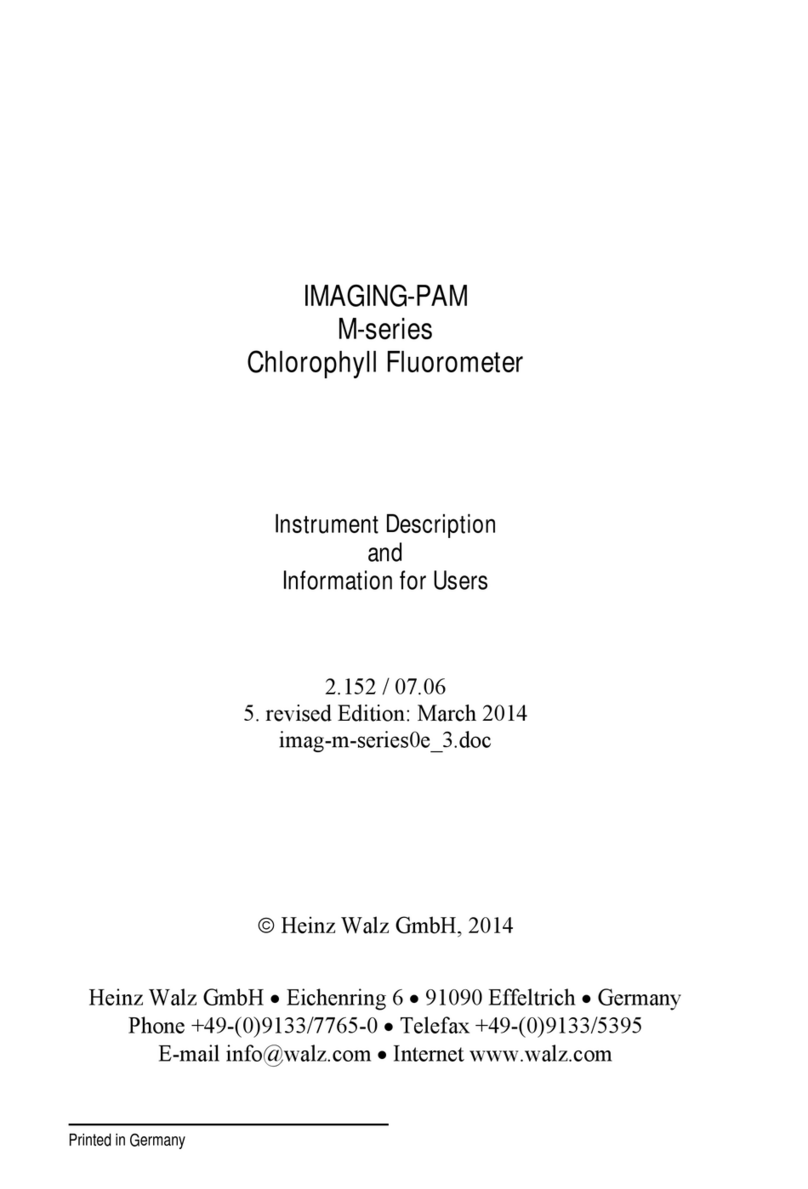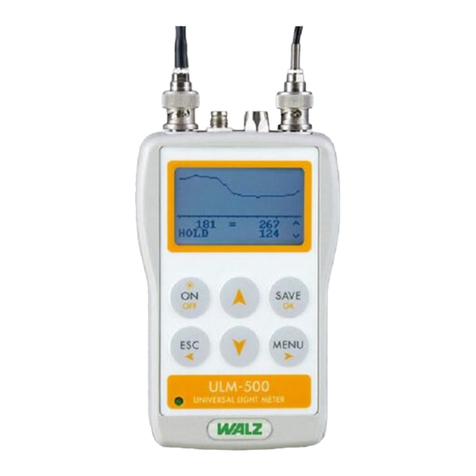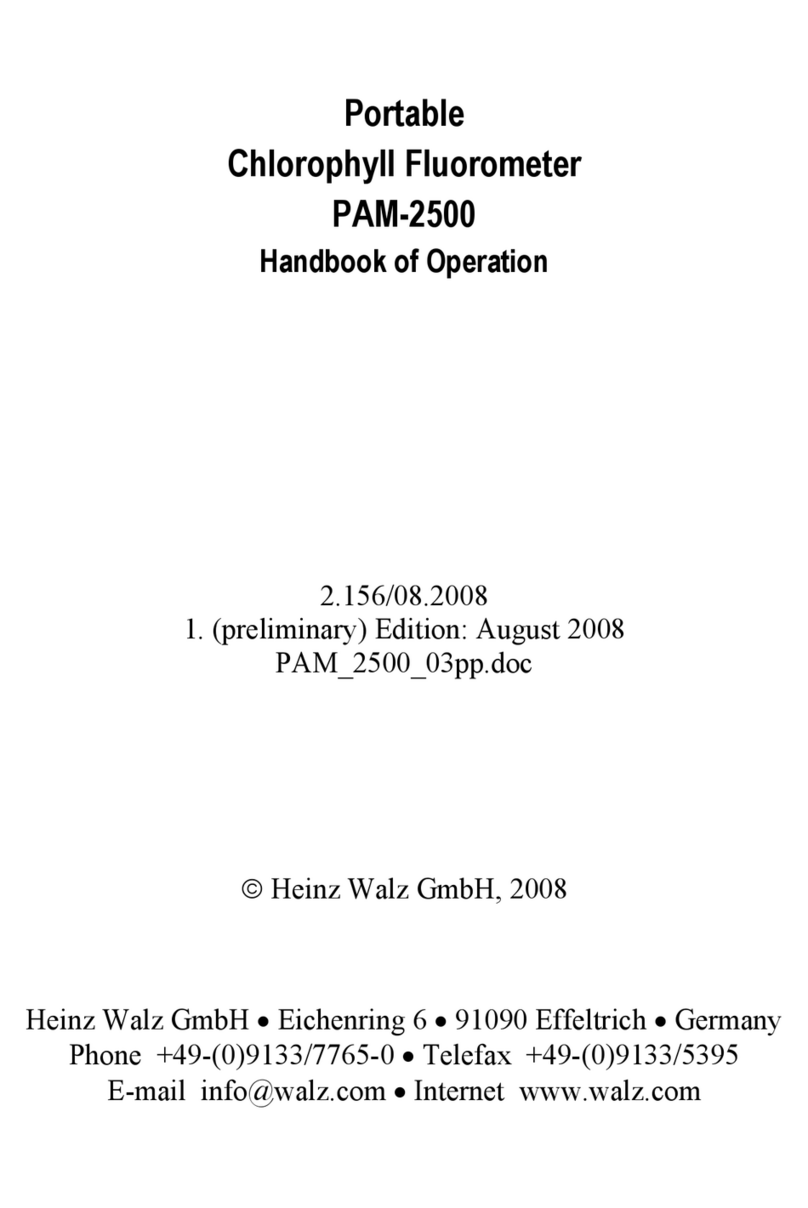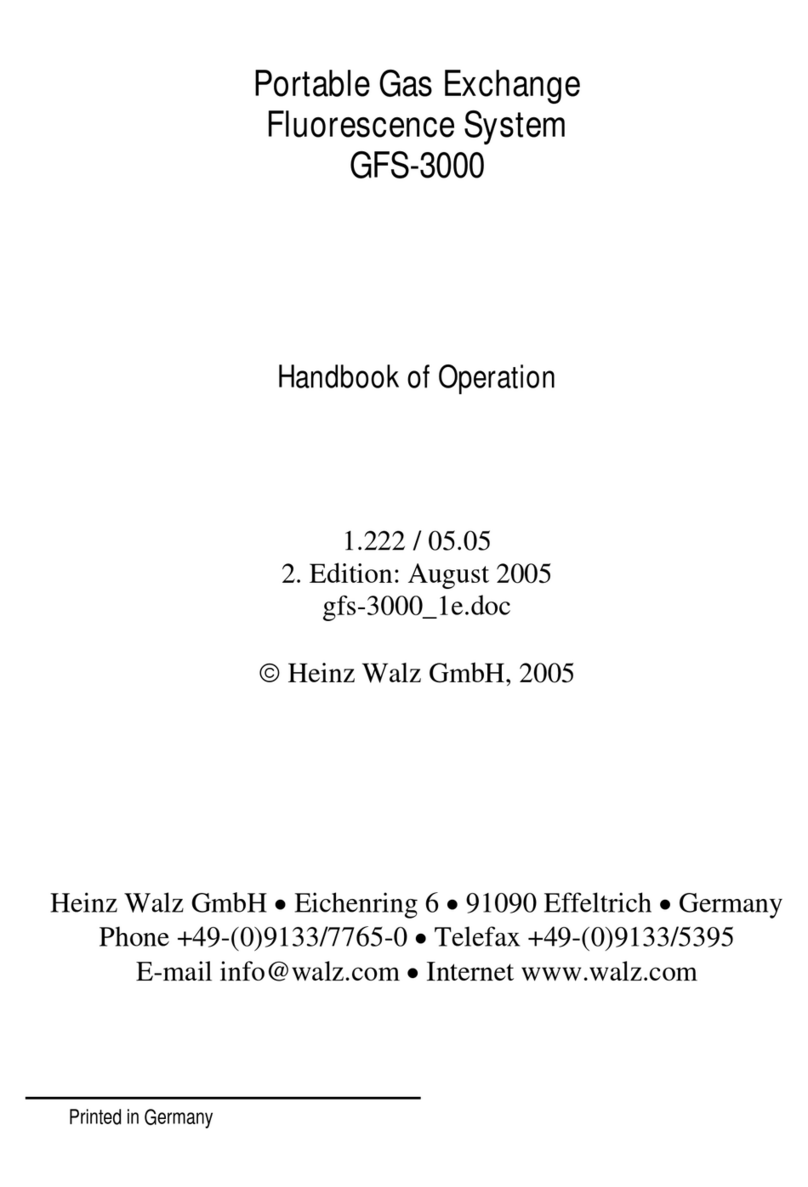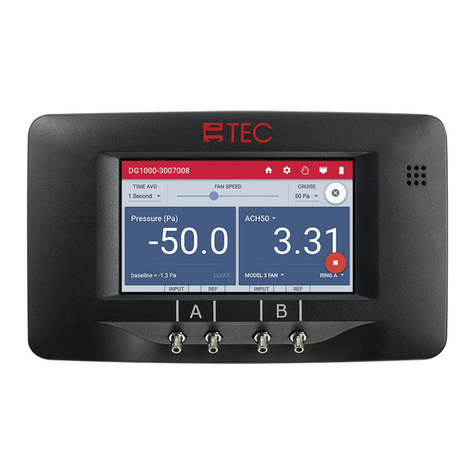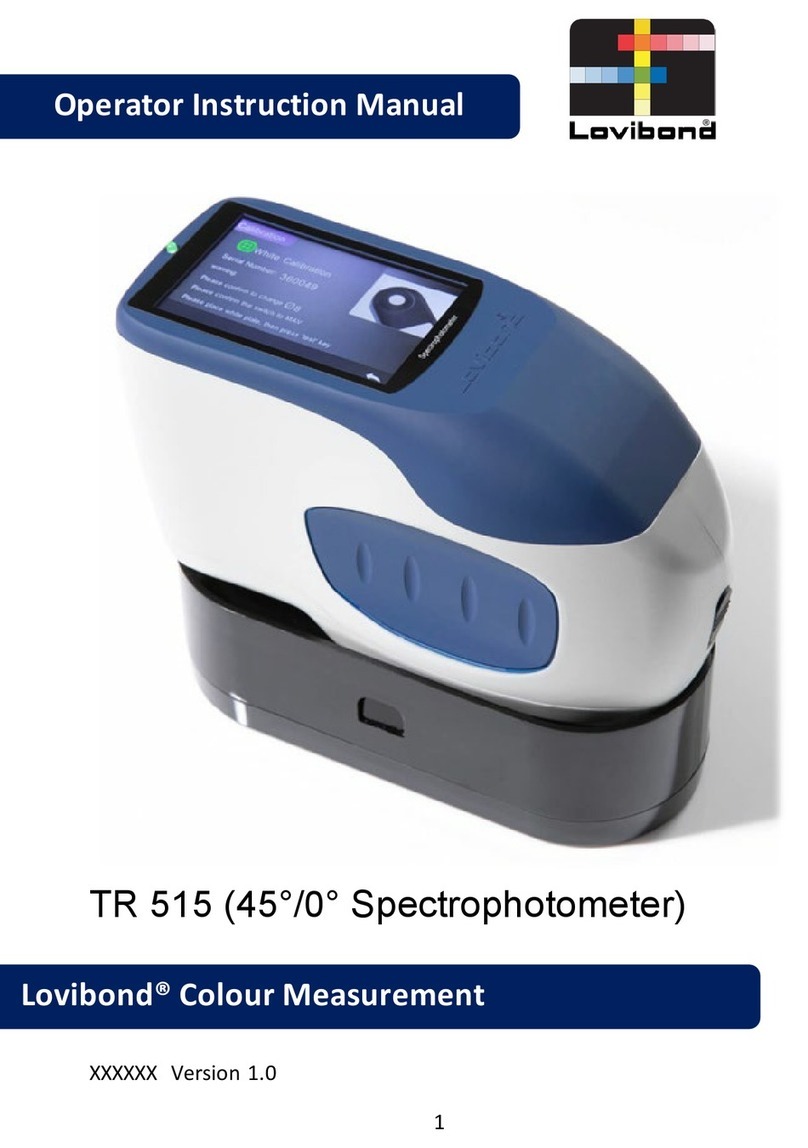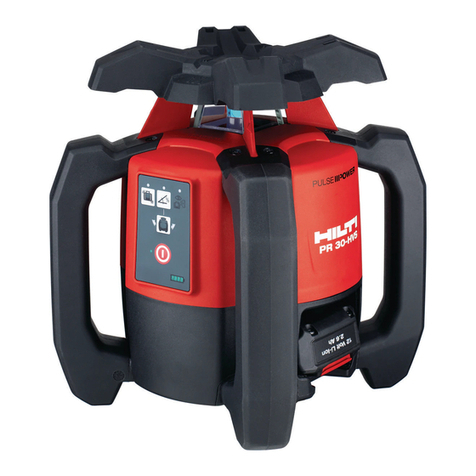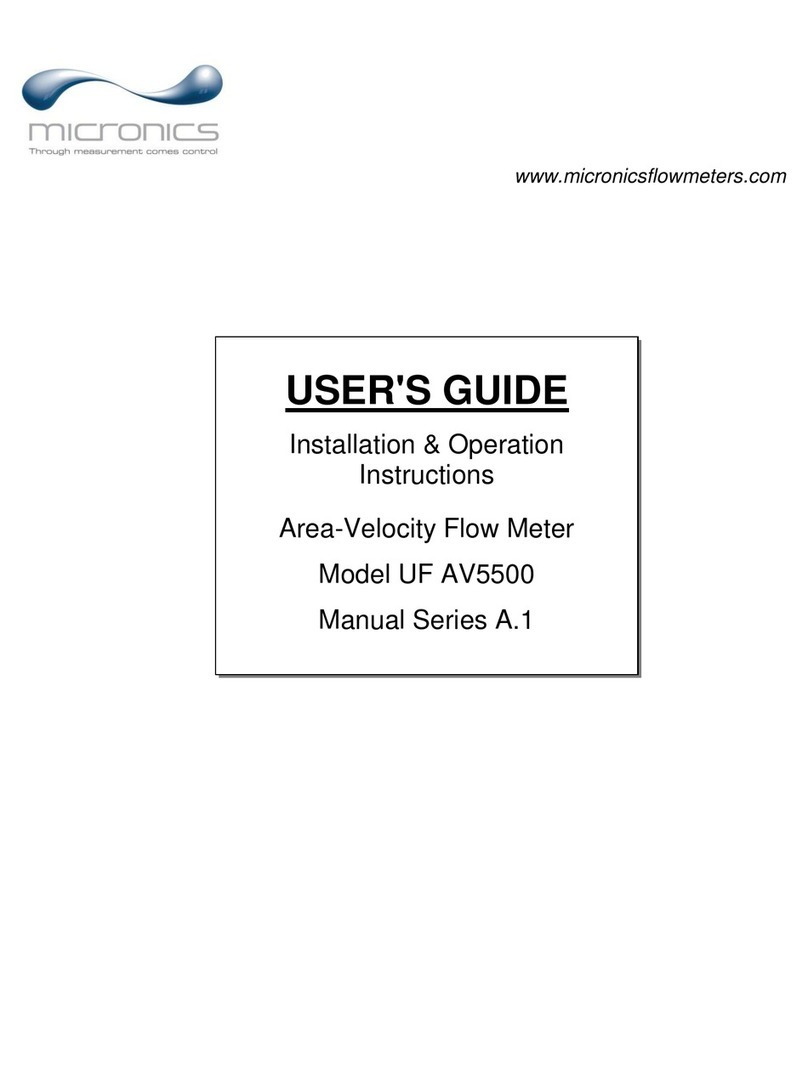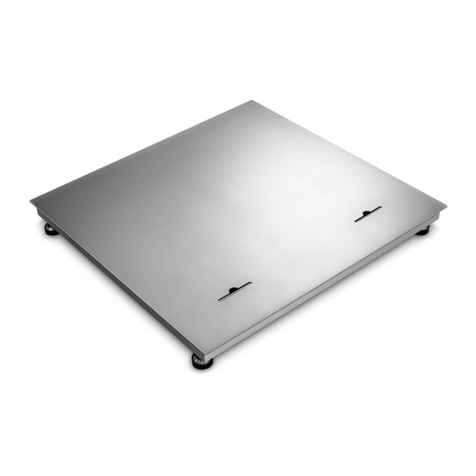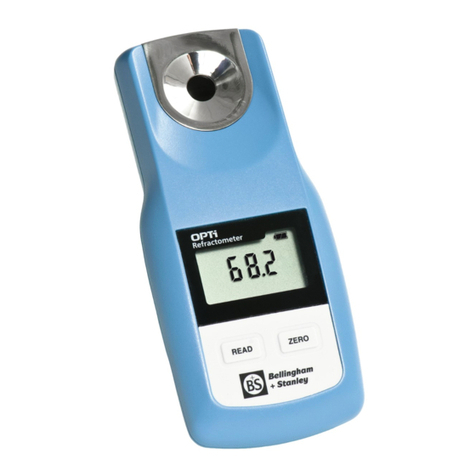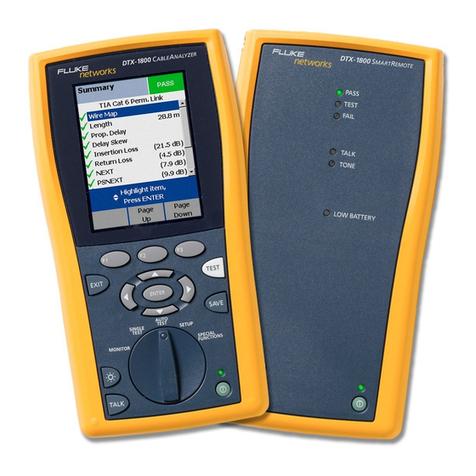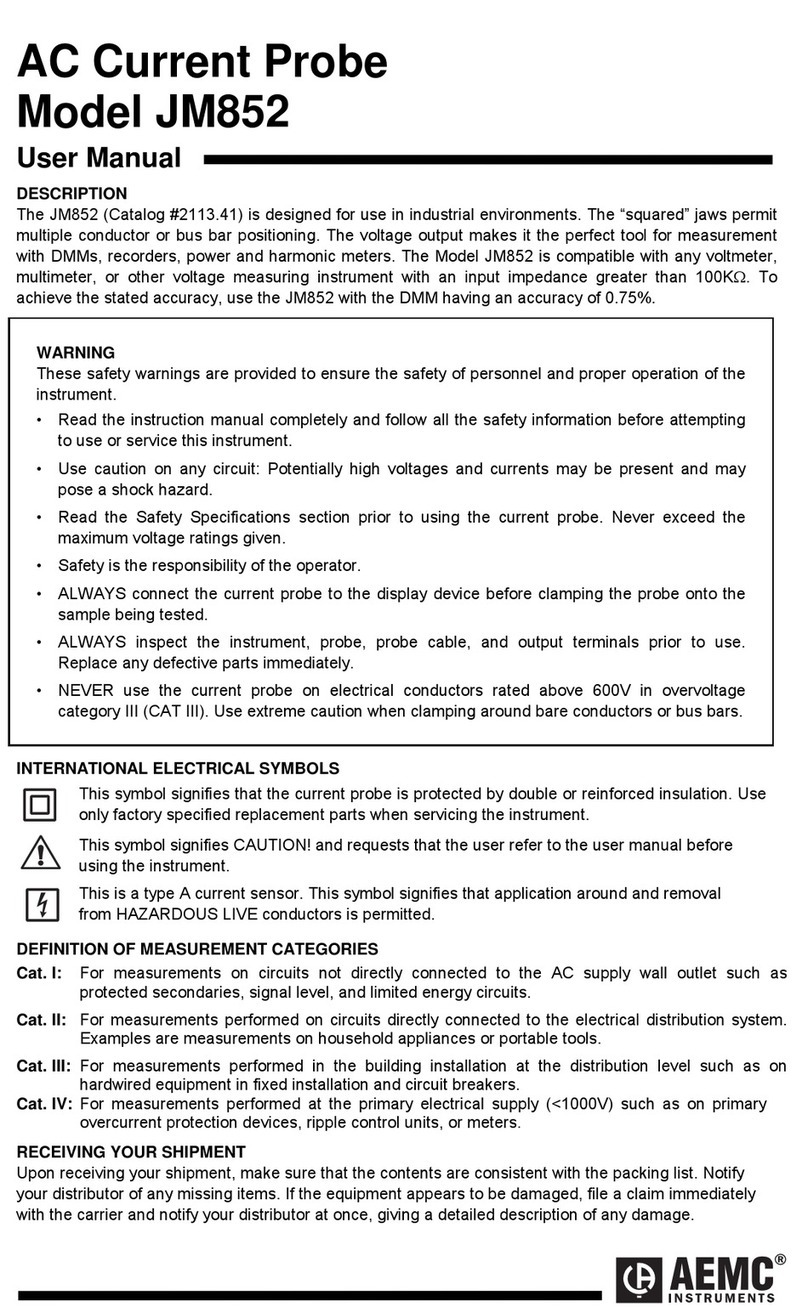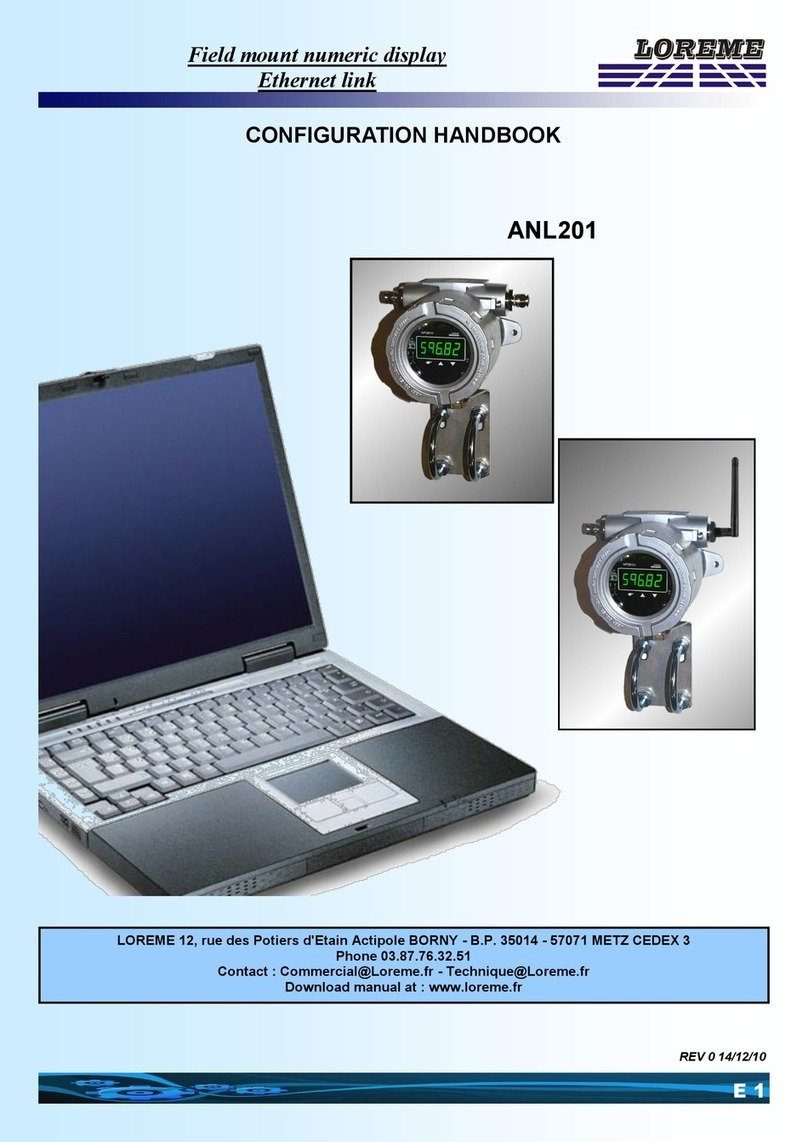Heinz Walz JUNIOR PAM Manual

JUNIOR-PAM
CHLOROPHYLL FLUOROMETER
Operator's Guide
2.154 / 12.07
1. Edition: December 07
JPM_070906.doc
Erhard Pfündel
©Heinz Walz GmbH, 2007
Heinz Walz GmbH •Eichenring 6 •91090 Effeltrich •Germany
Phone +49-(0)9133/7765-0 •Telefax ++49-(0)9133/5395
Printed in Germany


CONTENT
Content
1Safety Instructions 1
2JUNIOR-PAM: Description and Installation 3
2.1 JUNIOR-PAM Components 3
2.2 Assembly and Installation 4
2.2.1 Assembly of JUNIOR-PAM fluorometer 4
2.2.2 Installation of WinControl-3 software 5
3PAM Fluorometry and SAT Pulse Analysis 7
3.1 Pulse-Amplitude-Modulated Fluorescence 8
3.2 Saturating Pulse Analysis 10
4Simple Experiments 13
4.1 Testing the Fo´-Mode 13
4.2 Fluorescence Induction Curve 15
5Operation of the JUNIOR-PAM 17
5.1 The Initial Window / Chart Window 17
5.1.1 Box (1) - Main Menu Bar 18
5.1.2 Box (2) -Data Management and Graph Design 19
5.1.3 Box (3) - Sidebar 20
5.1.4 Box (4) - SAT Pulse Analysis 23
5.1.5 Box (5) - Online Data 25
5.1.6 Box (6) - SAT-Pulse Trigger 25
5.1.7 Box (7) - Experimental Parameters and Procedure 25
5.1.8 Box (8) - Graph Type and Fluorometer Settings 28
5.1.9 Box (9) - Axis Control 29
5.1.10 Box (10) - Ordinate Selection and Text Field 30
5.1.11 CHART - Selecting Data 30
5.2 Induction Curve Window 31
5.3 Light Curve Window 31
5.4 SAT Graph Window 32
I

CONTENT
5.4.1 Box (2) – Data Management 32
5.4.2 Box (3) – Sidebar 33
5.4.3 SAT Graph Panel 34
5.5 Report Window 34
5.5.1 Box (11) - Data Management 34
5.5.2 Box (12) - Report Data Field 37
5.6 Settings Window 37
5.6.1 Box (14) - Instrument Name & Reset 37
5.6.2 Box (15) - Measuring Parameters 38
5.6.3 Box (16) - Light Parameters 39
5.6.4 Box (17) - Program Parameters 40
5.6.5 Box (18) - PAR-List & LED 41
5.7 System Setting 41
6Acronyms and Equations 43
6.1 Relative Fluorescence Yields 43
6.1.1 Measurements with Dark-acclimated Samples 43
6.1.2 Measurements with Light-exposed (Treated) Samples 44
6.2 Fluorescence Quenching Coefficients 44
6.3 Relative Electron Transport Rate (ETR) 47
6.4 Light Curves 48
6.5 Literature Cited in Chapter 6 50
7Some Reviews on Chlorophyll Fluorescence 53
8JUNIOR-PAM Specifications* 55
9Warranty Conditions 57
II

SAFETY INSTRUCTIONS CHAPTER 1
1Safety Instructions
-Instructions. Read all the safety instructions and operating in-
structions thoroughly before using the device for the first time.
Keep these safety instructions and operating instructions some-
where safe in case you need to refer to them again in the future.
-Safety warnings. Pay heed to safety warnings on the device and
in the operating instructions. Follow the instructions for operation
and use of the device in every respect.
-Temperature. Do not install the device near any heat sources
such as a radiators, hot-air dryers, ovens, etc. Do not place naked
flame sources, such as lighted candles or Bunsen burners, on or
near the device.
-Moisture. Keep this device out of the rain and away from mois-
ture. Do not expose the apparatus to dripping or splashing and do
not place any object filled with liquid, such as drinking vessels,
beakers or test tubes, on or close to the device. Never use the de-
vice near water, for example near a sink.
-Solid objects. Take great care to ensure that no sharp objects
penetrate inside the device through openings of the casing.
-Service. Do not open the casing. There are no user serviceable
parts inside. Refer all servicing to qualified service personnel.
Servicing is required when the apparatus has been damaged in
any way, e.g., by exposure to wet conditions, excessive heat, or
has been dropped.
-Power source. Connect the device only to the 5 Volt power
source of a USB-A socket of a computer using the USB cable
supplied with the device. Run the USB cable so that no one can
step on it and nothing can rest on or against it.
1

CHAPTER 1 SAFETY INSTRUCTIONS
-Device not in use. If you are not going to use the device for some
time, remove the plug from the socket.
-Cleaning. Clean only with dry cloth.
2

DESCRIPTION & INSTALLATION CHAPTER 2
2JUNIOR-PAM: Description and Installation
2.1 JUNIOR-PAM Components
a) JUNIOR-PAM chlorophyll fluorometer.
b) USB cable to connect the JUNIOR-PAM fluorometer to a com-
puter.
c) CD-ROM including WinControl-3 software and JUNIOR-PAM
user’s manual.
d) Booklet: JUNIOR-PAM user’s manual (not shown in Fig. 2.1).
e) 400 x 1.5 mm (L x D) light guide.
f) Leaf clip and magnetic leaf clip.
g) Fluorescence standard foil.
Figure 2.1: JUNIOR-PAM components.
3

CHAPTER 2 DESCRIPTION & INSTALLATION
2.2 Assembly and Installation
2.2.1 Assembly of JUNIOR-PAM fluorometer
Unpack fiber optics. Carefully insert the fiber end with the silicone
sleeve into the fiber port of the JUNIOR-PAM until silicone sleeve and
fiber port get in contact. Frequently, the fiber encounters a resistance
during insertion: if this is the case, remove the fiber, carefully straighten
the fiber by hand, and insert again. Do not forcible overcome the resis-
tance. Finger-tighten the plastic screw of the light guide port.
Insert free end of light fiber into top of the fiber port of the magnetic
leaf clip (Fig. 3) until the fiber tip is flush with the sample-facing sur-
face of the fiber port. Finger-tighten the plastic screw of the magnetic
leaf clip. Now, the distance between fiber tip and the surface of a sample
held by the magnetic leaf clip 1mm.
Connect type B plug of the USB cable with the JUNIOR-PAM, and type
A plug with a computer running with Microsoft Windows 2000, XP or
Vista operating systems. At this point; the top side signal LED of the
JUNIOR-PAM should flash green at a frequency of 1 Hz, and, at the end
of the fiber, blue measuring light should be visible.
Figure 2.2: JUNIOR-PAM light guide port and Figure 2.3:
sockets. Magnetic leaf clip.
4

DESCRIPTION & INSTALLATION CHAPTER 2
2.2.2 Installation of WinControl-3 software
Depending on the type of CD-ROM delivered with the JUNIOR-PAM
you have to start installation with article a ) or article b ).
a) Your <Software & Manuals CD-ROM> contains only a setup file
(e. g., <WinControl-3-3.13-Setup.exe>) and this manual in PDF
file format.
Double click on the setup file and follow instructions. The setup routine
will create the folder <WinControl-3> containing WinControl-3 soft-
ware in the <c:\Program Files> directory. Further, a USB serial con-
verter driver will be installed, and shortcuts to the WinControl-3 soft-
ware will be created in the <Program> section of the Windows <Start>
menu and elsewhere, depending on your selection.
b) Your <Software & Manuals CD-ROM> contains the complete
collection of the Walz Software & Manuals. In this case, the CD
starts the default internet browser of your computer. (If automatic
browser start fails, double-click on <index.html> in the root direc-
tory of the <Software & Manuals> CD-ROM.)
Choose <Fluorescence Products> Î<JUNIOR-PAM> Î<PC software
WinControl-3>. Clicking on <WinControl-3> will start software instal-
lation as described above.
Using shortcuts in the <Start> menu, you can run two instances of Win-
Control-3 at the same time: one in the measuring mode (choose <Win-
Control-3>) and another one in the offline mode (choose WinControl-3 -
Offline>). Note that <WinControl-3 - Network Mode> does not work
with the JUNIOR-PAM fluorometer but requires WinControl-3-
compatible devices capable of RS485 communication (e.g., MONITOR-
ING PAM fluorometer). The measuring mode of WinControl-3 is also
initiated by double-clicking on the WinControl-3 shortcut on the Win-
dows desktop.
5

CHAPTER 2 DESCRIPTION & INSTALLATION
After launching the measuring mode of WinControl-3, the program
scans for WinControl-3-compatible devices connected to the computer.
With the JUNIOR-PAM attached, the bottom of the opening window of
WinControl-3 displays address number and name of your JUNIOR-
PAM, e.g., <#1: JUNIOR-PAM/II>. With the fluorescence standard or a
green leaf in the magnetic leaf clip, and “Meas. Light“ and “Rec.
Online” checked, the chart typically displays values greater than 200
digital units. Click <Autoscale> if data are not visible. In case the actu-
ally measured values are clearly lower than 200 digital units, make sure
that the silicone sleeve of the optical fiber is in contact with the fiber
port.
6

PAM FLUOROMETRY & SAT PULSE ANALYSIS CHAPTER 3
3PAM Fluorometry and SAT Pulse Analysis
Absorption of a visible photon by a chlorophyll molecule promotes an
electron of the absorbing molecule to a higher energy level. Usually, this
excited chlorophyll state is short-lived and returns promptly to the
ground state. Return to the ground state occurs with (1) the emission of
a red fluorescence quantum or (2) the emission of heat radiation at near
infrared and longer wavelengths, or (3), in photosynthetic membranes,
the performance of photochemical work. The latter three pathways com-
pete with each other. Therefore, decreased rates of heat release or photo-
chemistry increase fluo-
rescence emission. Also,
an increase in the inten-
sity of excitation radia-
tion increases fluores-
cence emission.
In photosynthetic membranes, between 2 and 10% of absorbed quanta
are emitted as photosystem II (PS II) fluorescence which is equivalent to
a (quantum) yield for PS II fluorescence between 0.02 and 0.1. In com-
parison, fluorescence from photosystem I is smaller and constant, and
will not be considered here. That the variability in chlorophyll fluores-
cence yield is related to photosynthesis has already been understood by
Kautsky and Hirsch in 1931 (Naturwissenschaften 19: 964). In the fol-
lowing 50 years, highly sensitive and fast fluorometers were developed
which contributed substantially to the elucidation of the basic mecha-
nisms involved in the complex process of photosynthesis.
Progress in photosynthesis research has been greatly stimulated by the
invention of the patented Pulse-Amplitude-Modulation (PAM) fluoro-
meter in the mid-1980s. The first PAM-101 chlorophyll fluorometer, and
newer models like portable above-ground and underwater fluorometers
(e.g., PAM-2100 and DIVING PAM), the robust outdoor monitoring
7

CHAPTER 3 PAM FLUOROMETRY & SAT PULSE ANALYSIS
fluorometer MONI-PAM, and imaging fluorometers (IMAGING-PAM
M series) have been successfully used all over the world.
PAM fluorometers, as many conventional fluorometers, use filter com-
binations which prevent the fluorometer’s excitation radiation from
reaching the photodetector. Different from conventional devices, the
PAM fluorometers measure only the fluorescence resulting from an
evenly pulsed measuring beam: the fluorescence caused by continuous
radiation is not measured. This permits the use of continuous radiation
to manipulate the fluorescence yield in photosynthetic membranes and
to carry out the so-called saturating pulse analyses.
Subsequently, the Pulse-Amplitude-Modulated fluorescence signal and
the saturating pulse analysis will be briefly explained.
3.1 Pulse-Amplitude-Modulated Fluorescence
In panel A of Figure 3.1, an excitation intensity regime is depicted
which consists of two separate 80 s intervals of actinic illumination of
different intensities. Always, a pulsed light source with constant pulse
height but rather low intensity is active. The pulsed radiation corre-
sponds to the measuring light of a PAM fluorometer.
If the latter light regime excites fluorescence from a JUNIOR-PAM
fluorescence standard, the signal obtained with a conventional fluoro-
meter is simply proportional to the excitation intensity (Fig. 3.1 B
“standard”). If the conventional instrument records fluorescence from a
leaf, typical “Kautsky-type” induction curves appear during actinic il-
lumination (Fig. 3.1 B “leaf”). For the same actinic light intensity, these
variations are determined by changes in the fluorescence yield. In addi-
tion, the intensity of actinic light controls the fluorescence signal as de-
monstrated by the upward shifted induction kinetics in the presence of
the higher actinic intensity compared to the kinetics obtained with lower
actinic light. Hence, conventional fluorometers respond to both, varia-
tions in fluorescence quantum yield and excitation light intensity.
8

PAM FLUOROMETRY & SAT PULSE ANALYSIS CHAPTER 3
Figure 3.1: Schematic representation of Pulse-Amplitude-Modulation
(PAM) fluorescence measurements.
PAM fluorometers measure only the height of fluorescence peaks
caused by the pulsed measuring light source (compare insert Panel B).
In the presence of uniform excitation pulses, and provided that chloro-
phyll optical properties remain constant during measurements, the signal
9

CHAPTER 3 PAM FLUOROMETRY & SAT PULSE ANALYSIS
recorded by PAM fluorometers is proportional to the fluorescence yield.
Therefore, the PAM measurements reveal that the fluorescence yield of
the standard is constant throughout the experiment, but the fluorescence
yield in a leaf varies significantly during the light exposure experiment
and exhibited rather similar induction curves despite the actinic light in-
tensities differed by a factor of 2 (Fig. 3.1. C).
3.2 Saturating Pulse Analysis
As explained above, the fluorescence yield in leaves is modulated by
two competing de-excitation pathways, photochemistry and heat emis-
sion. The decrease in fluorescence yield originating in increased photo-
chemistry is called photochemical fluorescence quenching, or photo-
chemical quenching. All other modifications of the fluorescence yield
are attributed to heat dissipation and are summarized as non-
photochemical fluorescence quenching, or non-photochemical quench-
ing. The saturating pulse analysis has been designed to distinguish be-
tween the two fluorescence quenching mechanisms.
Figure 3.2 shows a fluorescence curve induced by actinic (i. e., photo-
chemically active) illumination. During the dark periods which flank the
induction curve, the integrated intensity of the pulsed measuring light is
very low and does induce noticeable rates of electron transport. There-
fore, under dark conditions, virtually all PS II reaction centers are in the
open state and able to convert excitation energy into photochemistry
with maximum efficiency, that is, photochemical quenching is maximal.
A saturating pulse (SP) is delivered in the dark period preceding illumi-
nation and another one at the end of illumination. The term “saturating”
means that the light is strong and long enough to fully reduce the elec-
tron transport chain between the two photosystems so that PS II lacks
electron acceptors. In the absence of electron acceptors, PS II reaction
centers cannot perform photochemical work and become closed, that is,
photochemical quenching becomes zero. Under these conditions, maxi-
10

PAM FLUOROMETRY & SAT PULSE ANALYSIS CHAPTER 3
mum fluorescence levels are reached which are denoted as Fm and Fm´
in the dark-acclimated and light-exposed sample, respectively.
In Fig. 3.2, several seconds of far red illumination succeed each saturat-
ing flash. Far red radiation is preferably absorbed by photosystem I but
to a much lesser degree by photosystem II. The selective operation of
photosystem I quickly withdraws electrons from the intersystem elec-
tron chain ensuing fast opening of the PS II reaction centers and maxi-
mal photochemical quenching. The resulting minimum fluorescence
levels are denoted as Fo and Fo´ in the dark-acclimated and light-
exposed sample, respectively.
Figure 3.2: Saturating Pulse Analysis.
11

CHAPTER 3 PAM FLUOROMETRY & SAT PULSE ANALYSIS
During actinic illumination, a proton gradient across the photosynthetic
membranes (ΔpH) is formed and the xanthophyll, zeaxanthin, is synthe-
sized. The ΔpH and the concentration of zeaxanthin represent significant
factors for stimulating non-photochemical quenching. Subsequent to il-
lumination, the pH gradient collapses and the zeaxanthin is retrans-
formed into violaxanthin (sketched in Fig. 3.2).
Importantly, the far red-stimulated opening of PS II reaction centers oc-
curs faster than the ΔpH collapse and zeaxanthin retransformation. Con-
sequently, in the presence of far red illumination, the minimum fluores-
cence level right after actinic light exposure represents the fluorescence
yield of open PS II reaction centers with the previous non-
photochemical quenching still present. Without far red illumination, the
velocities of reaction center opening and ΔpH breakdown would be
comparable so that PS II reaction centers become fully open only after a
considerable part of non-photochemical quenching has decayed.
In conclusion, the primary information of saturating pulse analysis is:
(1) the fluorescence increase caused by the decrease from maximum to
minimum photochemical quenching in the dark-acclimated and light-
exposed leaf (FMminus F0and FM’ minus F0’, respectively). (2) the fluo-
rescence decrease caused by actinic light-activated non-photochemical
quenching in the absence and at maximum photochemical quenching
(FMminus FM’ and F0minus F0’, respectively), and (3), derived from the
position of the induction curve just before the saturating pulse (the F´
level) relative to the interval delimited by FM’ and F0’, the degree of
PS II reaction center closure.
Usually, not absolute fluorescence values or fluorescence differences are
used to measure the PS II state but fluorescence quotients. The fluores-
cence quotients calculated by the WinControl-3 program are summa-
rized in Table 6.1 (Chapter 6). Some publications providing background
information to the various evaluation methods used in saturating pulse
analyses are compiled in sections 6.5 and 7.
12

SIMPLE EXPERIMENTS CHAPTER 4
4Simple Experiments
Chapter 4 introduces two simple experiments which can be performed
without in-depth knowledge of the WinControl-3 software. To exploit
the multifaceted functionality of the WinControl-3 software, it is rec-
ommended to study Chapter 5 which includes a complete presentation
of the software’s capabilities.
The subsequent experiments require that the JUNIOR-PAM system is
set up according to Chapter 2. Also, all experiment start with a leaf
which has been acclimated to dark or dim light conditions for30 min-
utes. With the leaf situated in the magnetic leaf clip, the Fo fluorescence
level should not exceed 600 counts to avoid signal saturation during
Fo,Fm determination.
4.1 Testing the Fo´-Mode
-Start WinControl-3 and locate the fluorescence trace on the chart. If
the signal is not in view, make sure that <Rec. Online> is checked
and click the <Autoscale> button.
-Press the <Fo,Fm> button to determine the Fv/Fm ratio which indi-
cates the maximum photochemical efficiency of PS II. The data ap-
pear on top of the <Result> sidebar (see Figure 4.1 for typical data).
Use <Autoscale> to view the entire signal.
-Make sure that the Fo´-Mode is unchecked. Click on the <Program>
tab and check <Act.+Yield>. The <Act.+Yield> command illumi-
nates the sample for a given time and carries out a saturating pulse
analysis at start and end of the illumination period. Watch the Kaut-
sky induction kinetics. After illumination, wait until the fluorescence
signal arrives at the initial level.
-Activate the <Fo´-Mode> and start <Act.+Yield> again. With the
<Fo´-Mode> active, far red illumination is switched on directly after
each saturating flash actinic light exposure with the result that the
13

CHAPTER 4 SIMPLE EXPERIMENTS
fluorescence intensity decreases faster and drops to a lower value
than in the previous <Act.+Yield> step (see Fig. 4.1.).
It is recommended to repeat the latter two steps to establish a clear pat-
tern of the effect of far red illumination.
Figure 4.1: Testing the Fo´-Mode
14

SIMPLE EXPERIMENTS CHAPTER 4
4.2 Fluorescence Induction Curve
Figure 4.2: Fluorescence Induction Curve
-If data from previous experiments are present, you may start a new
record by clicking the <Rec.> tab and the <New Record>.
-Locate the fluorescence trace on the chart and determine Fv/Fm.
-Switch on <Act. Light> and start repetitive saturating pulse analyses
by checking <Clock>. Switch off <Act. Light> after a couple of
minutes.
-Fig. 4.2 shows typical results of an induction curve experiment: right
after onset of actinic illumination, the photochemical yield of PS II
15

CHAPTER 4 SIMPLE EXPERIMENTS
(Y(II)) drops close to zero which is related to the dark idling state of
photosynthesis at which PS II electrons cannot be processed. The
subsequent activation of energy-consuming photosynthetic processes
recovers the PS II yield to intermediate values. Non-photochemical
quenching (blue symbols) is absent at start of actinic illumination be-
cause a trans-membrane ΔpH is absent. Ongoing illumination build-
up the ΔpH and, hence non-photochemical quenching. Towards the
end of illumination, part of the ΔpH is dissipated via the chloroplast
ATP synthase in response to the growing ATP requirements of carbon
fixation.
-Switching off actinic illumination shuts down PS II photochemical
rates ensuing reoxidation of the intersystem electron transport and
recovery to initial values of the PS II photochemical yield. In paral-
lel, the trans-membrane ΔpH decays and non-photochemical quench-
ing drops.
-Note that of fluorescence induction and recovery curves can be per-
formed automatically using the <IC+Recov.> command available in
the <Program> field.
16
Table of contents
Other Heinz Walz Measuring Instrument manuals
Popular Measuring Instrument manuals by other brands
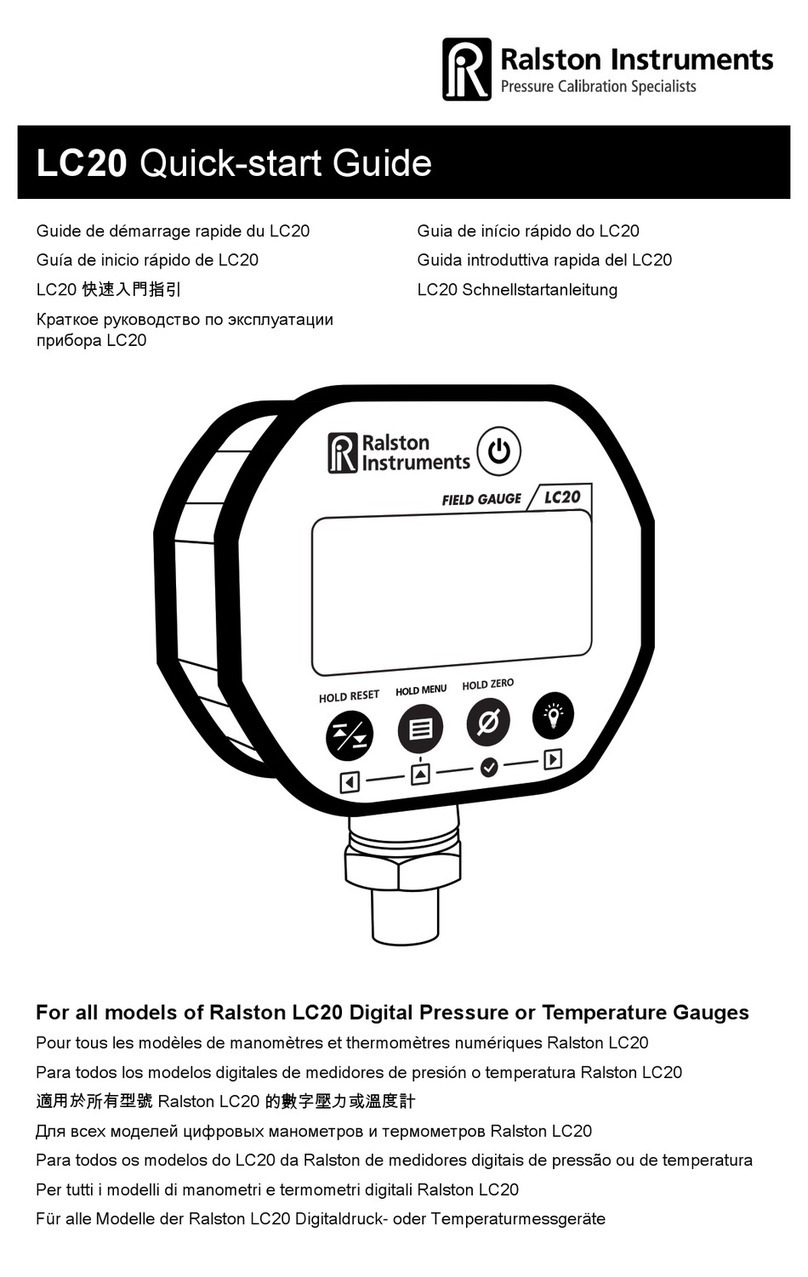
Ralston Instruments
Ralston Instruments LC-20 quick start guide
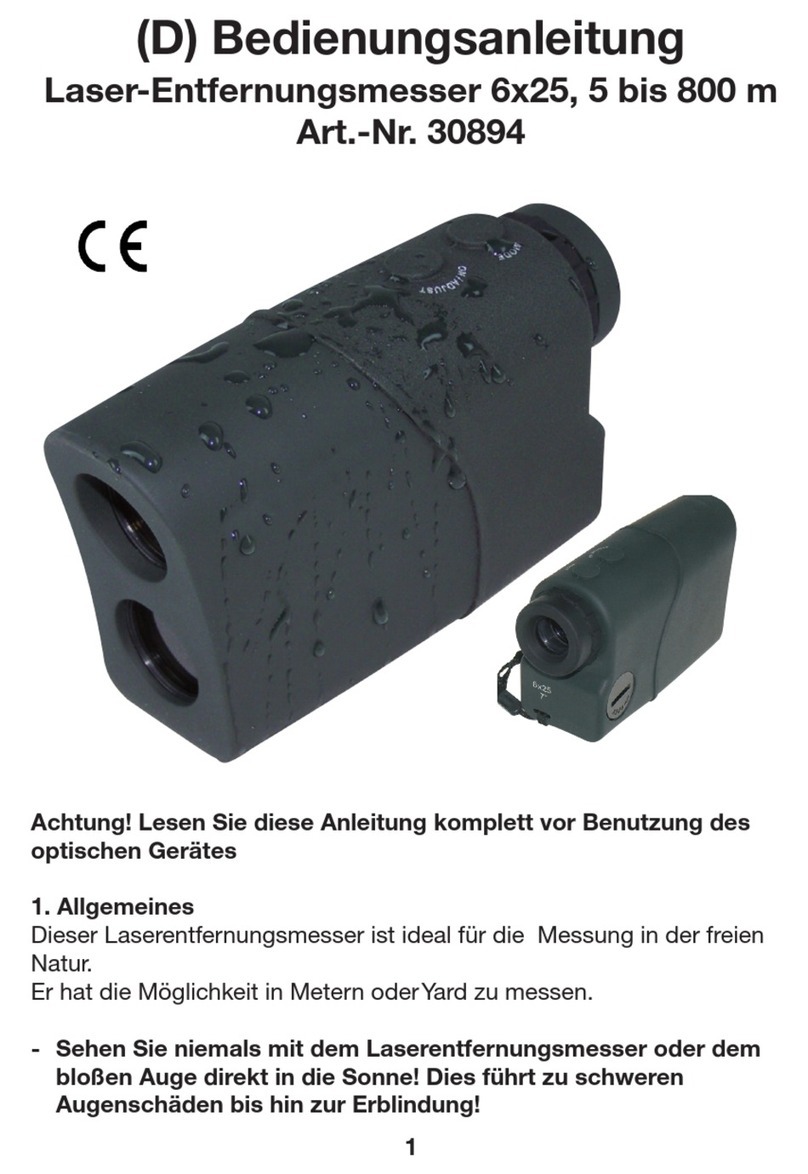
Berger & Schroter
Berger & Schroter 30894 operating instructions
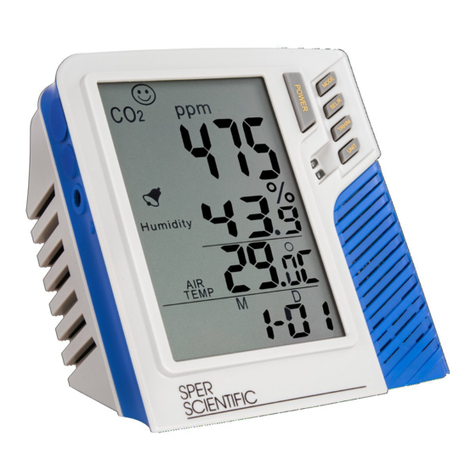
Sper scientific
Sper scientific 800048 instruction manual

Fluke
Fluke FIBER OneShot Quick reference guide
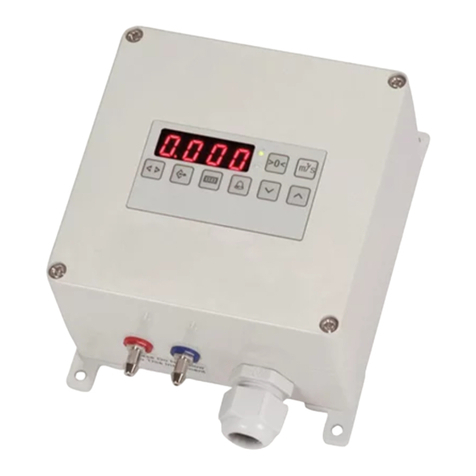
Oceanic Systems
Oceanic Systems 5700 user manual
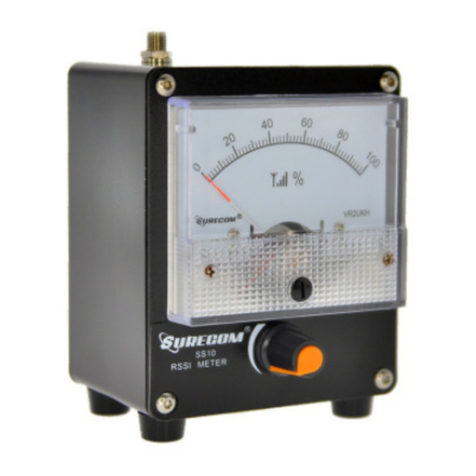
Surecom
Surecom SS-10 user manual
